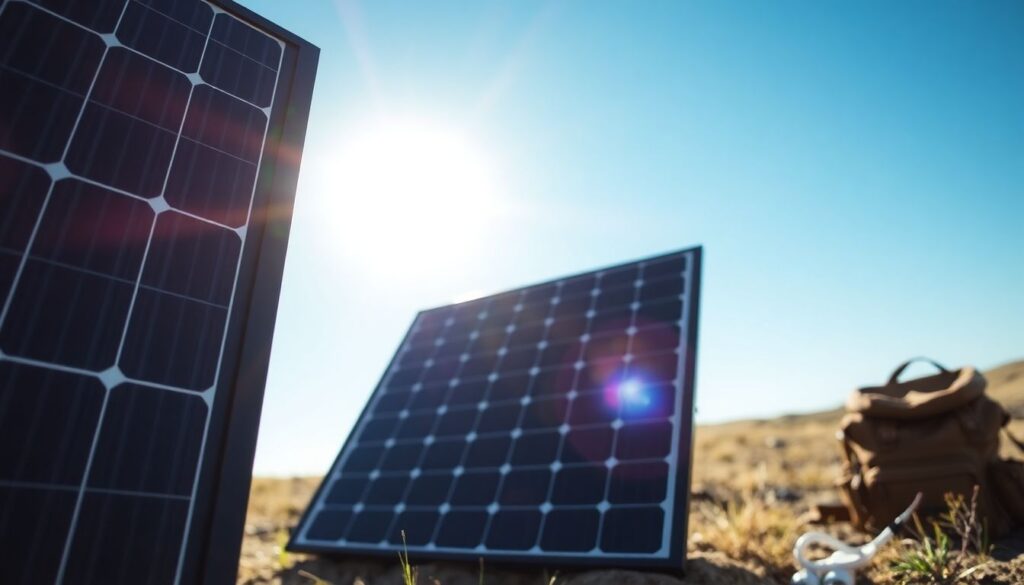Have you ever found yourself in the midst of a power outage, wishing you could keep your essential devices running, or your refrigerator humming, without relying on noisy, polluting generators? Or perhaps you’ve dreamt of escaping the grid, embracing a self-sufficient lifestyle, and harnessing the power of the sun to fuel your adventures? You’re not alone. Welcome to the world of portable solar power, where renewable energy meets off-grid survival, and the only limit is your imagination. In this comprehensive guide, we’re going to delve into the fascinating realm of DIY solar power, exploring how you can create your own emergency electricity solutions, and gain the freedom and self-reliance that comes with it.
According to the International Energy Agency, solar photovoltaic (PV) capacity has been growing exponentially, with a staggering 500% increase in global capacity since 2010. This rapid growth is a testament to the power of the sun, which provides more than enough energy to meet our global demand, if only we could harness it effectively. But what if you could tap into this boundless energy source, not just to power your home, but to keep your portable devices charged, your camp lights on, and your emergency communications ready, even in the most remote locations? That’s the promise of portable solar power.
In this article, we agree that relying solely on the grid for your energy needs can be risky, expensive, and environmentally taxing. We promise to provide you with a detailed, step-by-step guide to building your own portable solar power system, from understanding the basics of solar panels and charge controllers, to selecting the right batteries and inverters, and even creating DIY solar projects to suit your specific needs. By the end of this article, you’ll not only have the knowledge and tools to create your own emergency electricity solutions, but you’ll also gain a newfound appreciation for the power of the sun and the freedom that comes with self-reliance.
So, whether you’re a seasoned prepper looking to enhance your emergency kit, an avid camper eager to reduce your environmental impact, or simply a curious individual interested in the possibilities of renewable energy, this article is for you. So, let’s roll up our sleeves, grab our tools, and dive into the exciting world of DIY solar power for off-grid survival. The sun is waiting, and it’s time to harness its power!
Harnessing the Sun: DIY Portable Solar Power for Off-Grid Survival
In the realm of off-grid living, the sun becomes not just a source of warmth and light, but a lifeline, a constant companion that fuels our daily needs. Harnessing the Sun: DIY Portable Solar Power for Off-Grid Survival is a testament to human ingenuity and our ability to adapt to our environment. Imagine this: you’re miles away from the nearest power grid, yet your devices are fully charged, your water is purified, and your food is preserved, all thanks to the power of the sun. This isn’t a futuristic dream, but a reality that can be achieved with the right knowledge and tools. This guide isn’t about waiting for the sun to rise and set, but about capturing its energy and transforming it into usable power. It’s about understanding the science behind solar panels, the art of DIY electronics, and the practicality of off-grid living. It’s about learning to build your own portable solar power system, from selecting the right solar panels to designing a circuit that can charge your devices, power your lights, and even run small appliances. It’s about understanding the importance of energy storage and how to choose the right battery for your needs. It’s about learning to live in harmony with nature, not as a spectator, but as a participant. So, if you’re ready to take control of your power needs, to live off the grid, and to harness the sun’s energy, then this guide is for you. Let’s embark on this journey together, one solar panel at a time.
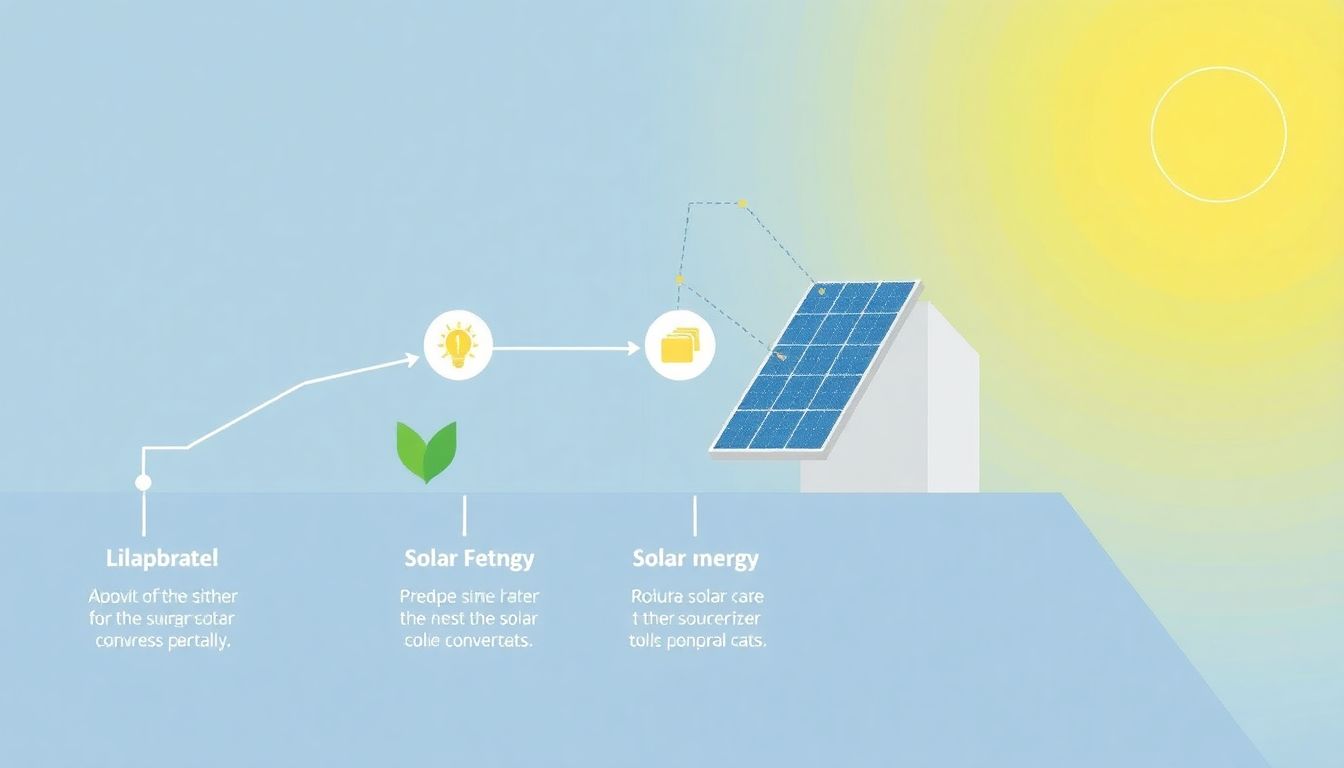
Understanding Portable Solar Power
Portable solar power, a beacon of self-sufficiency and sustainability, has become an indispensable tool for off-grid survival and eco-conscious individuals alike. At its core, it harnesses the boundless energy of the sun, transforming it into electricity that can be used to power a myriad of devices, from smartphones to entire off-grid homes. Understanding the basics of this technology is not only empowering but also crucial in making informed decisions about our energy consumption and the future of our planet.
The science behind solar panels is as fascinating as it is ingenious. Solar panels are composed of photovoltaic cells, which are made up of semiconducting materials, such as silicon. When sunlight hits these cells, it knocks loose some electrons, creating a flow of electricity. This process, known as the photovoltaic effect, was discovered in 1839 by French physicist Alexandre-Edmond Becquerel, but it wasn’t until the mid-20th century that solar cells were developed that could efficiently convert sunlight into electricity.
Portable solar power’s importance in off-grid survival cannot be overstated. It provides a clean, renewable source of energy that is independent of traditional power grids. This makes it an invaluable tool for those living in remote areas, as well as for emergency preparedness and disaster relief situations. Moreover, it offers a silent, odorless, and non-polluting alternative to traditional fuels like gasoline or diesel, making it an environmentally friendly choice.
When comparing portable solar power to other renewable energy sources, it’s clear that it has several advantages. Unlike wind power, which requires consistent wind speeds, or hydropower, which relies on water flow, solar power can be generated anywhere the sun shines. Additionally, solar panels have a long lifespan, with many lasting over 25 years with minimal maintenance. However, it’s important to note that solar power is dependent on sunlight, so it may not provide a constant source of power, especially in areas with low sunlight or during nighttime hours. To mitigate this, many portable solar power systems come with built-in batteries for energy storage.
In conclusion, portable solar power is a powerful tool for off-grid survival and a sustainable alternative to traditional energy sources. By understanding the science behind solar panels and their advantages, we can make informed decisions about our energy consumption and contribute to a cleaner, more sustainable future.

Choosing the Right Solar Panel
Embarking on the quest for the perfect portable solar panel is an exciting journey towards sustainable power on the go. Let’s navigate through this process together, ensuring you find the ideal companion for your adventures.
First, consider the power-hungry devices you’ll be charging. This leads us to the crucial factor of wattage. Solar panels are measured in watts, indicating the amount of power they can generate. For instance, a 10-watt panel can fully charge a typical smartphone in about two hours under optimal sunlight. If you’re planning to charge multiple devices or power-hungry gadgets like laptops, consider panels with higher wattage, such as 50W or 100W.
Next, let’s talk portability. When you’re out in the wild, the last thing you want is a heavy, cumbersome solar panel slowing you down. Look for panels that are lightweight and foldable, with a compact design that fits easily into your backpack. Some panels even come with a carrying case for added convenience.
Durability is another key factor. Solar panels are designed to withstand the elements, but some are more robust than others. If you’re planning on roughing it in the great outdoors, opt for panels with reinforced corners, waterproofing, and a solid construction that can handle a few bumps and bruises.
Now, let’s address the elephant in the room
- cost. Portable solar panels come in a wide range of prices, from budget-friendly to high-end. While it’s tempting to go for the cheapest option, remember that you often get what you pay for. Investing in a quality panel may cost more upfront, but it could save you money in the long run by lasting longer and performing better.
Finally, let’s consider some scenario-specific recommendations:
- Backpacking: For ultralight adventures, consider panels like the Goal Zero Venture 30 or the Anker PowerPort Solar, which balance power output with weight and size.
- Camping: If you’re setting up camp for a few days, you might want something more powerful, like the Renogy 100W Foldable Solar Panel, which can charge multiple devices at once.
- Emergency Situations: In case of power outages or natural disasters, having a reliable, high-wattage panel like the Jackery SolarSaga 100W can be a lifesaver. It’s also wise to have a portable power station to store the generated energy.
Happy solar shopping, and may your adventures be powered by the sun!
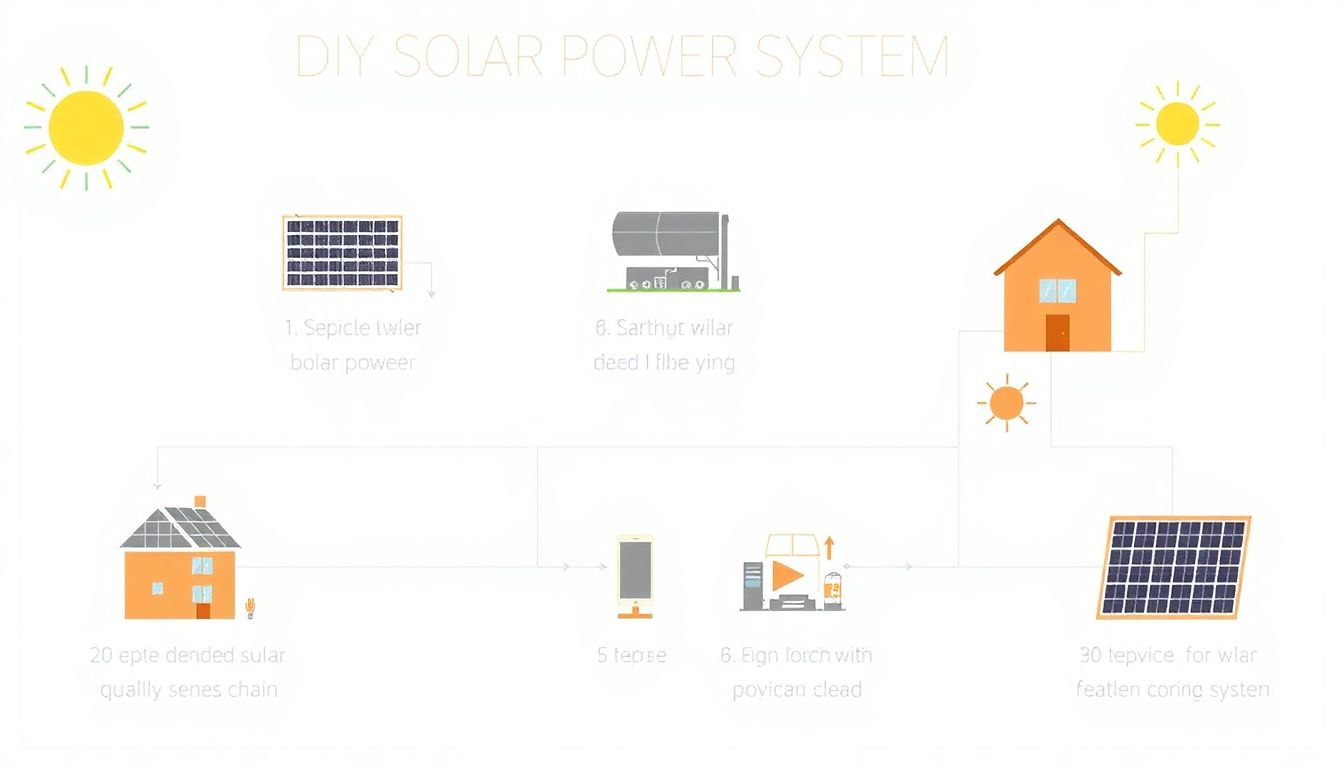
Setting Up Your DIY Solar System
Embarking on a DIY solar power system adventure is an exciting step towards energy independence and sustainability. Let’s dive into the process of setting up your own solar system, step by step. First, you’ll need to gather the necessary components. Here’s a quick rundown:
- Solar Panels: These are the powerhouses of your system, converting sunlight into direct current (DC) electricity. Choose panels based on your energy needs and available roof space. Monocrystalline and polycrystalline are popular choices.
- Charge Controller: This device regulates the voltage and current coming from your solar panels, preventing overcharging of your batteries. It also displays essential system information. MPPT controllers are more efficient but costlier.
- Batteries: Deep-cycle batteries, like sealed lead-acid or lithium-ion, store the energy collected by your solar panels. Their capacity (measured in amp-hours) should match your daily energy needs.
- Inverter: This component converts the stored DC power into alternating current (AC) power, suitable for running household appliances. Choose an inverter with a wattage rating that matches your peak power demand.
Now that you’ve got your components, let’s set up your system:
- Mount your solar panels on a sturdy rack or your roof, ensuring they face the sun and are tilted at an optimal angle (around 30 degrees in many regions).
- Connect the solar panels to the charge controller using MC4 connectors.
- Connect the charge controller to your batteries using appropriate cables and terminals.
- Connect your inverter to the batteries, following the manufacturer’s instructions.
- Finally, connect your inverter to your home’s electrical panel, ensuring you follow local electrical codes and regulations.
Always remember safety first! Wear appropriate personal protective equipment (PPE) when working with electrical components. Regularly inspect your system for any signs of wear or damage, and keep it clean to ensure optimal performance. Enjoy your newfound energy independence!
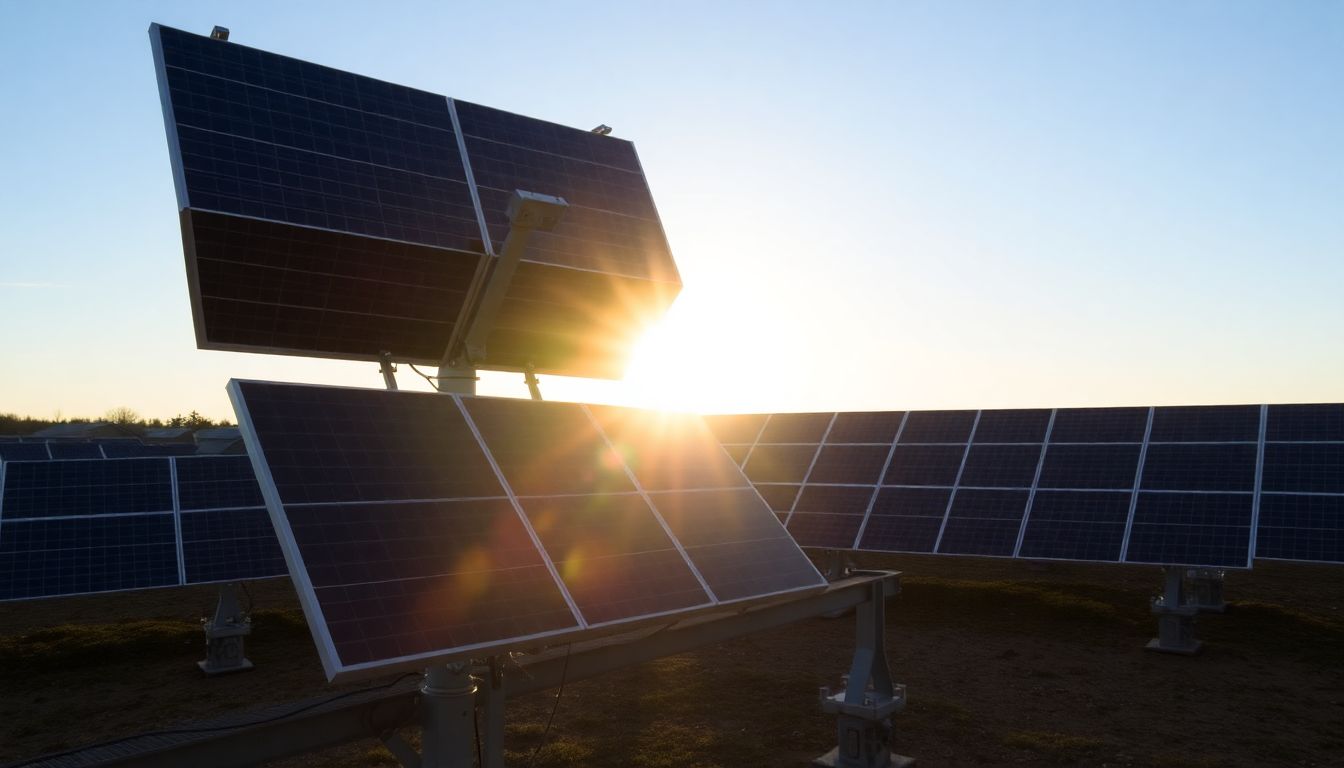
Maximizing Solar Energy Harvest
Maximizing solar energy harvest is a multifaceted endeavor that involves strategic positioning, weather monitoring, and regular maintenance. Let’s delve into these aspects to ensure your solar panels are working at peak efficiency.
The first step in maximizing solar energy harvest is to position your solar panels optimally. Ideally, they should face south (in the Northern Hemisphere) or north (in the Southern Hemisphere) to capture the most sunlight throughout the day. However, if your roof’s orientation isn’t ideal, don’t despair. Even panels that aren’t perfectly aligned can still generate a significant amount of energy.
To further enhance efficiency, consider installing a solar tracking system. These systems adjust the angle and orientation of your panels throughout the day to follow the sun’s path. This can increase energy output by up to 40% compared to fixed panels.
Monitoring weather patterns is another crucial aspect. Cloudy days and seasonal changes can significantly impact solar energy production. By tracking these patterns, you can anticipate dips in energy output and adjust your usage accordingly. For instance, you might want to use energy-intensive appliances during peak sunlight hours.
Regular maintenance is also key to keeping your solar panels in tip-top shape. Dust, dirt, and debris can accumulate on the panels, blocking sunlight and reducing efficiency. Therefore, it’s important to clean them regularly. If your panels are on a slanted roof, rain should do the job. But if they’re flat or in a dusty area, you might need to clean them manually. Additionally, keep an eye out for any cracks or damage to the panels. If you notice any issues, don’t hesitate to call a professional for repairs.
In conclusion, maximizing solar energy harvest is a combination of strategic planning, vigilant monitoring, and regular care. By positioning your panels optimally, using tracking systems, monitoring weather patterns, and maintaining your panels, you can ensure they’re working at their best, saving you money and reducing your carbon footprint.
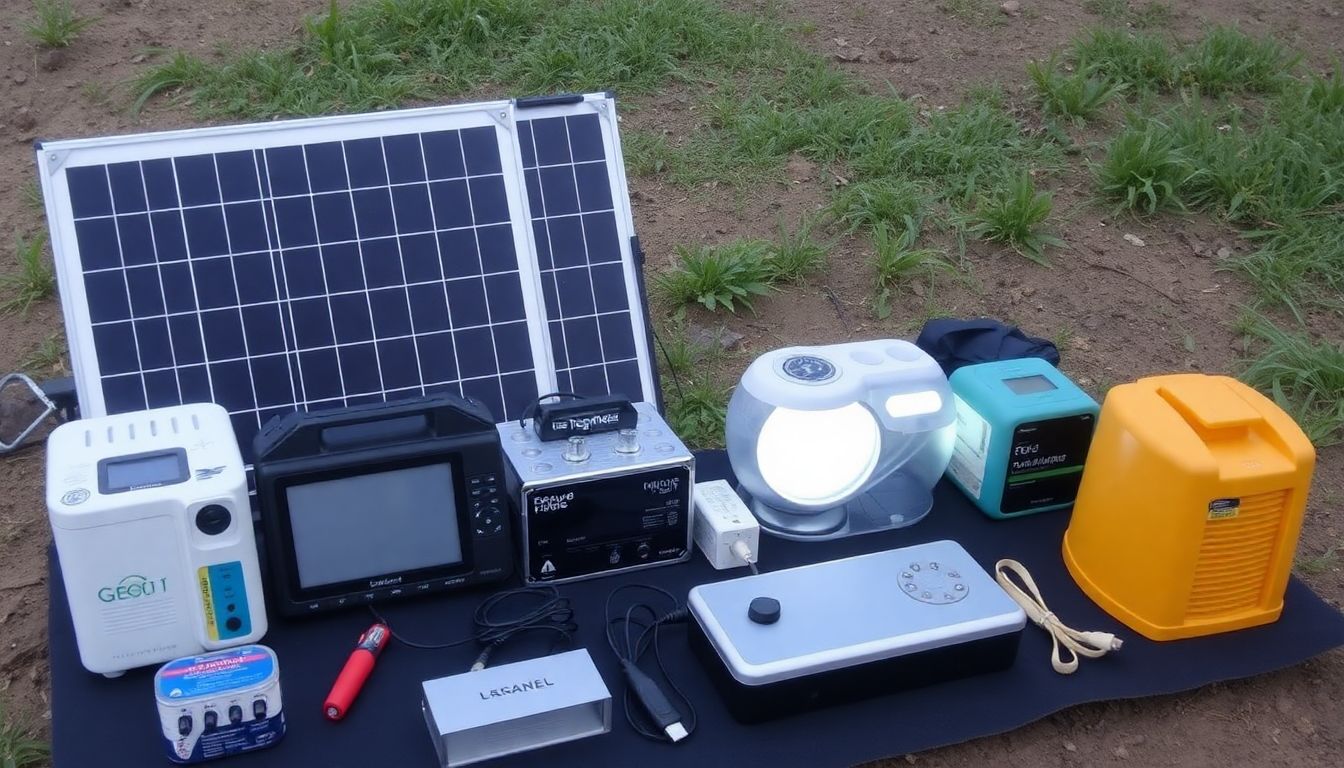
Powering Your Gear with Solar
Embracing the power of the sun to fuel your gear is not only eco-friendly but also convenient, especially when you’re off the grid. Let’s explore the diverse range of devices and appliances that can be powered using portable solar energy.
First, let’s consider USB-powered devices. These are typically low-power gadgets that can be charged directly from a solar panel connected to a USB port. Examples include smartphones, tablets, portable speakers, and even some small LED lights. The power requirement for these devices is usually measured in milliamp-hours (mAh) or watts (W). To determine the power needs, simply check the specifications of your device. For instance, a typical smartphone with a 3000 mAh battery would require around 12W of power to fully charge.
Next, we have 12V DC devices. These are typically larger and more powerful than USB devices. Examples include 12V car fridges, portable fans, and some LED light strips. To power these, you’ll need a solar panel with a 12V output and an appropriate charge controller. The power requirement for these devices is usually measured in watts (W). To determine the power needs, check the device’s specifications. For example, a 12V car fridge might require around 40W of power to run.
Lastly, let’s talk about AC devices. These are your typical household appliances that run on alternating current, like laptops, TVs, and small kitchen appliances. To power these with solar, you’ll need an inverter to convert the DC power from your solar panel into AC power. The power requirement for these devices is usually measured in watts (W). To determine the power needs, check the device’s specifications. For instance, a typical laptop might require around 65W of power to run.
When determining the power requirements of your gear, remember to consider not just the power needed to run the device, but also the power needed to charge it. Also, consider the size and efficiency of your solar panel. A larger, more efficient panel will generate more power, but it will also be heavier and more expensive.
In conclusion, powering your gear with solar is a versatile and sustainable option. With a bit of planning and the right equipment, you can keep your devices charged and ready to go, even when you’re off the grid.

Emergency Electricity: Solar Power in Action
In the ever-evolving landscape of renewable energy, solar power has emerged as a lifesaver in emergency situations. Portable solar power systems have proven their mettle in real-life scenarios, providing a beacon of hope in the darkest hours. Let’s delve into a few instances where solar power has been the difference between connectivity and isolation, life and death, and light and darkness.
One such scenario unfolded in the aftermath of Hurricane Maria in Puerto Rico. The storm left the island in a state of emergency, with widespread power outages lasting for months. In such a critical situation, communication was key. Solar-powered chargers were distributed among the affected population, enabling them to charge their phones and stay connected with loved ones and emergency services. This underscores the first crucial role of solar power in emergencies: charging communication devices.
In medical contexts, solar power has been a literal lifesaver. In off-grid clinics and hospitals, solar panels have been used to power life-saving equipment. For instance, in remote African villages, solar-powered refrigerators have been used to store vaccines, ensuring their potency and preventing disease outbreaks. Similarly, solar-powered incubators have provided warmth and care to newborns in areas without reliable electricity. This demonstrates the second vital role of solar power: powering medical equipment.
Light, often taken for granted, becomes a precious commodity in power outages. Solar-powered lighting solutions have brought illumination to dark corners, both literally and metaphorically. In disaster zones, solar-powered lanterns have been used to navigate through debris, provide light for rescue operations, and bring a sense of normalcy to those affected. This highlights the third significant role of solar power: providing lighting in off-grid situations.
Creating an emergency solar power kit is a proactive step towards preparedness. Here’s a simple guide to help you build one:
- Start with a portable solar panel. Ensure it’s foldable and lightweight for easy transportation.
- Invest in a power bank with a high capacity to store energy from the solar panel.
- Include a solar-powered flashlight or lantern for lighting up dark spaces.
- Add a solar-powered charger specifically designed for medical devices, if you or someone in your family relies on one.
- Don’t forget to pack a multi-port USB charger to power multiple devices simultaneously.
Store this kit in an easily accessible place, and you’ll be ready to face any power outage with confidence.
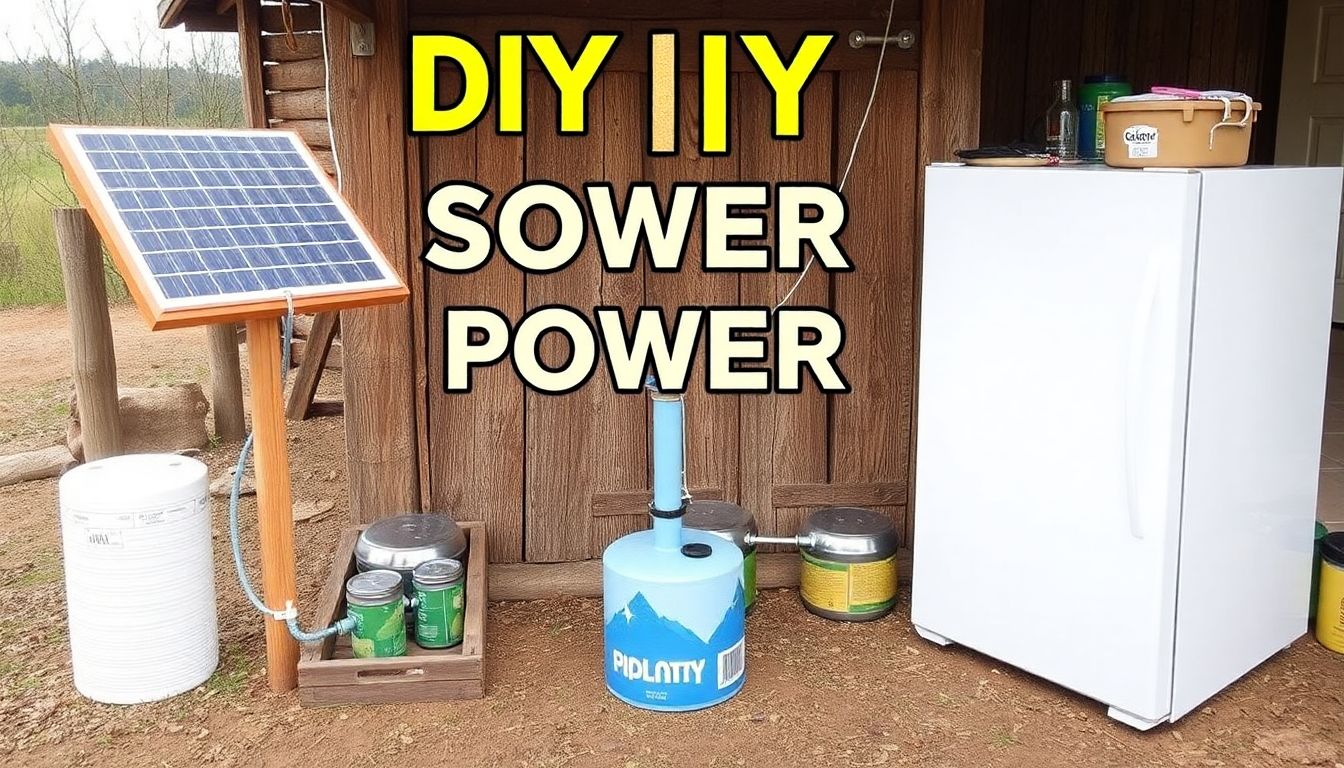
DIY Solar Power Projects for Off-Grid Living
Embracing off-grid living often means harnessing the power of the sun, and there’s no better way to do that than with these creative DIY solar power projects. Let’s dive into three fantastic projects that will make your off-grid life more comfortable and sustainable.
Solar-Powered Water Pump:
- A reliable water source is crucial for off-grid living. A solar-powered water pump ensures you have water even when the grid is down. Here’s a simple step-by-step guide:
- Gather your materials: solar panel, water pump, deep cycle battery, charge controller, and PVC piping.
- Mount the solar panel in a sunny spot and connect it to the charge controller.
- Connect the battery to the charge controller and the water pump to the battery.
- Submerge the pump in your water source and run the piping to where you need the water.
- Tip: Use a float switch to prevent the pump from running dry.
Off-Grid Refrigeration:
- Keeping food fresh off-grid is possible with a solar-powered refrigerator. Here’s a simple design using a cooler, solar panel, and a 12V DC compressor:
- Insulate a cooler with foam or reflective bubble insulation.
- Install a 12V DC compressor and fan inside the cooler.
- Mount a solar panel and connect it to a charge controller and battery.
- Connect the battery to the compressor and fan.
- Tip: Use a thermostat to regulate the temperature and save power.
Solar-Powered Lighting Systems:
- Light up your off-grid space with these simple solar-powered lights. You’ll need solar panels, LED lights, batteries, and a charge controller.
- Mount the solar panel in a sunny spot and connect it to the charge controller.
- Connect the battery to the charge controller and the LED lights to the battery.
- Position the lights where you need them.
- Tip: Use motion sensors to save power and deter wildlife.
Each of these projects requires some basic electrical knowledge and tools, but they’re all well within the reach of the average DIY enthusiast. So, grab your tools and let’s get started! The sun is waiting, and it’s free!
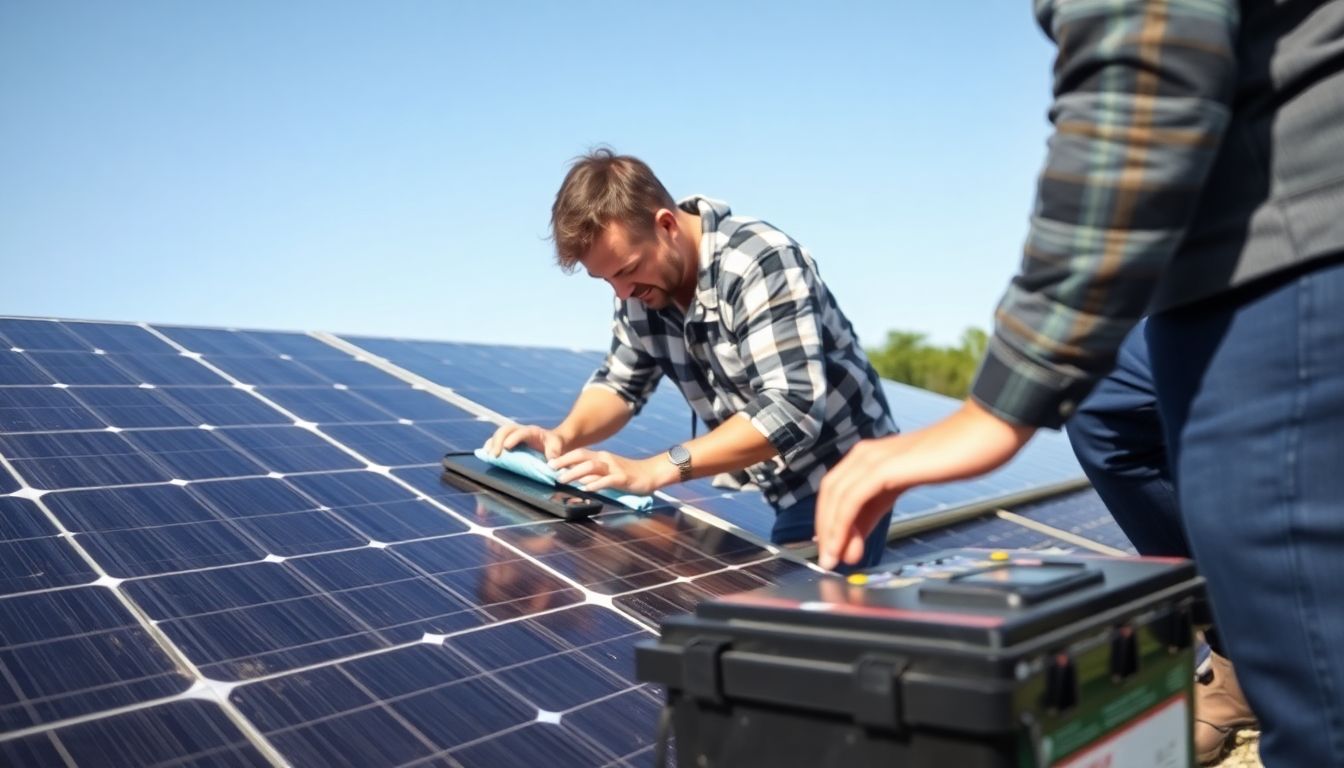
Maintaining and Upgrading Your DIY Solar System
Maintaining and upgrading your DIY solar power system is a rewarding task that ensures your clean energy source remains efficient and reliable. Regular maintenance is key to preserving your system’s performance and longevity. Start by scheduling regular cleanings for your solar panels. Dust, dirt, and bird droppings can accumulate and reduce their efficiency. Use a soft-bristled brush or a squeegee with mild soap and water to gently clean the panels. Be sure to do this on a cool, cloudy day to avoid any risk of damage from overheating.
Next, monitor your battery health. Batteries are the heart of your solar system, storing the energy collected by your panels. Check their voltage and temperature regularly. Most batteries have a built-in monitor, or you can use a multimeter. If you notice any significant drops in voltage or unusual temperature changes, it might be time to replace your batteries.
Upgrading your DIY solar system can increase its capacity and efficiency. Consider upgrading your solar panels to newer, more efficient models. Monocrystalline panels, for instance, have higher efficiency rates than polycrystalline panels. You can also add more panels to your system to increase its capacity.
Another upgrade to consider is your inverter. A newer, more efficient inverter can convert the DC power from your batteries to AC power for your home more effectively. Some inverters also have built-in battery chargers, allowing you to charge your batteries from the grid when your solar panels aren’t producing enough power.
Lastly, consider upgrading your battery bank. Newer battery technologies, like lithium-ion batteries, have higher capacity and longer lifespans than traditional lead-acid batteries. They also have a higher initial cost but can save you money in the long run due to their longevity.
Always remember to consult with a professional when making significant upgrades to your system. They can provide guidance based on your specific system and energy needs. By maintaining and upgrading your DIY solar system, you’re not only ensuring a reliable energy source but also contributing to a cleaner, more sustainable future.
FAQ
What is the difference between portable solar and stationary solar systems?
How do I determine the right size of a portable solar system for my off-grid survival needs?
What are the key components of a portable solar system?
- Solar Panels: These convert sunlight into direct current (DC) electricity. The number and size of panels will depend on your power needs and the available sunlight in your location.
- Charge Controller: This device regulates the voltage and current coming from the solar panels, preventing overcharging of the battery and ensuring the battery’s longevity.
- Battery: Stores the electricity generated by the solar panels. Deep-cycle batteries, like sealed lead-acid, gel, or lithium-ion, are typically used in portable solar systems.
- Inverter: Converts the DC power from the battery into alternating current (AC) power, which is the standard for most household appliances and electronics.
- Cables and Connectors: These connect the various components together, allowing the system to function as a whole.
How can I optimize the performance of my portable solar system?
- Positioning: Place your solar panels in a location that receives maximum sunlight, ideally facing south (in the Northern Hemisphere) and tilted at an angle equal to your latitude plus 10-15 degrees.
- Shading: Avoid placing your solar panels near tall objects that may cast shadows, as shading can significantly reduce their output.
- Cleanliness: Keep your solar panels clean to ensure maximum sunlight absorption. Dust, dirt, and debris can reduce their efficiency.
- Battery Maintenance: Regularly check and maintain your battery to ensure its longevity and optimal performance. This may include equalization charges, cleaning terminals, and monitoring its state of charge.
- Efficient Appliances: Use energy-efficient appliances and devices to reduce your overall power consumption and minimize the strain on your solar system.
What are some common misconceptions about renewable energy, specifically solar power?
How can I stay safe while using a portable solar system for emergency electricity?
- Battery Safety: Always follow the manufacturer’s guidelines for charging, discharging, and maintaining your battery. Never attempt to open or modify a battery, as this can cause serious injury or damage. Keep batteries in a well-ventilated area, as they can produce hydrogen gas during charging, which is flammable.
- Electrical Safety: Ensure that all electrical connections are secure and properly insulated. Use appropriate fuses or circuit breakers to protect your system from overloads or short circuits. Never attempt to repair or modify electrical components without proper training and safety equipment.
- Fire Safety: Keep your solar system away from flammable materials, and maintain a clear area around it to minimize the risk of fire. Regularly inspect your system for any signs of damage or wear that could pose a fire hazard.
- Safety During Emergencies: In emergency situations, prioritize your safety and the safety of others. Do not attempt to use your solar system if it has been damaged or if you are unsure about its safety. Always follow the instructions provided by local authorities and emergency services.



